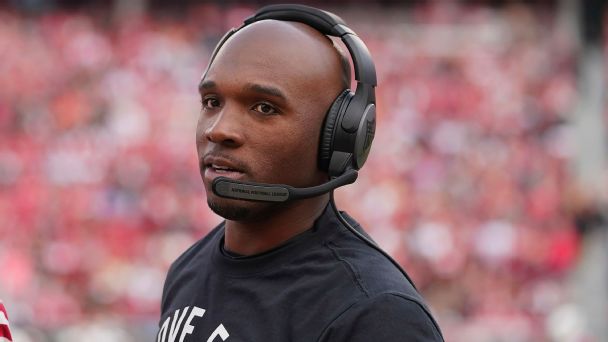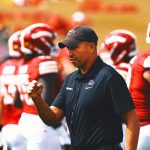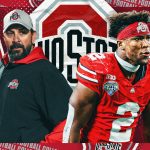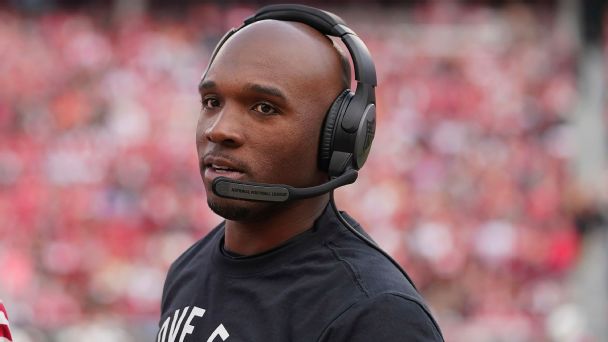
SANTA CLARA, Calif. — It didn’t take long after the Houston Texans used the No. 33 pick in the 2006 NFL draft on linebacker DeMeco Ryans for everyone in the organization to recognize something special.
As fate would have it, that Texans coaching staff included a handful of future San Francisco 49ers coaches. A young Kyle Shanahan was in charge of wide receivers; Robert Saleh, the former Niners defensive coordinator, was a defensive assistant; and Johnny Holland, the team’s linebackers coach, held the same role in Houston.
Whenever the team would practice, Shanahan was struck by how quickly Ryans took charge, barking out playcalls, lining up teammates and making plays.
“He came in and ran that defense from day one as a rookie and that always stuck out to me,” Shanahan said.
Saleh was in his first year as a full-time NFL coach and working with the linebackers when Ryans arrived. As he learned the ropes of the job, Saleh couldn’t help but believe Ryans was already working at an advanced level.
“I always felt like he would make a really good football coach because of the way he prepared for and played the game,” Saleh said.
That preparation created plenty of success on the field, as Ryans earned Defensive Rookie of the Year honors in 2006, a first-team All-Pro nod in 2007 and Pro Bowl berths in 2007 and 2009. From 2006 to 2009, only London Fletcher posted more tackles than Ryans’ 518. Ryans finished a 10-year career with 970 tackles, 46 passes defended, 13.5 sacks and seven interceptions in 140 games.
Saleh’s suspicions that Ryans’ approach to playing would translate to coaching have also proved true. Ryans’ rise to become one of the NFL’s hottest head-coaching candidates seems meteoric on the surface.
Ryans spent one season as the quality control coach and two coaching inside linebackers before replacing defensive coordinator Robert Saleh, who left to become the coach of the New York Jets, in 2021.
But Ryans’ ascent to the doorstep of the NFL’s head-coaching fraternity has actually been brewing for much longer. His grandmother predicted it when Ryans was young, he got a small taste of it after an injury in 2010 and was completely sold late in his career when he embraced a mentorship role for the player drafted to replace him.
Along the way, Ryans has figured out how to use his playing experience to relate to players while asserting himself as a coach unafraid to tell players when they aren’t meeting the standard.
In Sunday’s NFC Divisional round meeting against the Dallas Cowboys (6:30 p.m. ET, Levi’s Stadium, Fox), Ryans will lead a defense that in two seasons with him as coordinator ranks second in the NFL in points (18.9) and yards per game allowed (305.3), fourth in ESPN’s defensive efficiency (60.7) and yards per play (5.04) and fifth in defensive EPA (67.02).
Ryans’ performance has earned him interview requests from the Arizona Cardinals, Denver Broncos, Indianapolis Colts, Texans and Carolina Panthers — every team with an opening for their vacant head-coaching positions. He’s slated to interview with the Broncos and Texans this week and the others at a later date.
It’s also garnered unanimous praise from those who play for him.
“Just the way he is as a coach and a leader, he’s the best coach I’ve been around,” defensive end Nick Bosa said.
ASK THOSE WHO have been around Ryans what he’s like and you’ll inevitably hear words like positive, calm and even-keeled. Ryans likes to tell players that “energy vampires” aren’t allowed, meaning nobody with a negative attitude is permitted in his meeting rooms.
It’s a character trait Ryans attributes to his mother, affectionately known in his hometown of Bessemer, Alabama, as “Miss Martha.” To support Ryans and his three older siblings, Miss Martha worked at a manufacturing plant in town during the day and a cleaning service in the evening, often returning home long after her kids had gone to bed.
“I think my mom is really quiet and low key,” Ryans said. “She can be just fine sitting in the house or being around everybody and not say much and just feel everything that’s going on. Everybody had tough situations, but she was always just steady through it all. And I think I just get that calming demeanor from her.”
Never did that trait come in handy more than Oct. 17, 2010, when Ryans tore his left Achilles tendon just before halftime of a loss to the Kansas City Chiefs. The following spring, as Ryans was rehabilitating the injury in Birmingham because of the NFL lockout, he caught up with former Alabama teammate Dennis Alexander.
Alexander had become the coach of Ryans’ alma mater, Bessemer City High, and asked Ryans if he was interested in helping out as defensive coordinator during spring football. Ryans first figured he’d pop over to Bessemer in the afternoons and be home a few hours later.
Instead, Ryans found himself sitting in his house until 9 or 10 p.m., drawing up schemes for a team that had only one spring game to play against an opponent.
It was Ryans’ first taste of coaching, though it had been foretold to him long before that it would someday be his passion.
“My grandmother always told me like, you’ll probably be a coach one day,” Ryans said. As it turned out, that one game, which Bessemer City won, was all it took for Ryans to see what a difference his football knowledge could make.
“To see how excited, how elated those kids were to see the looks on their faces from like being a part of it and just coaching them and putting them in position to make plays, I was like ‘Wow, that was cool.’ That always stuck in my mind.”
FOLLOWING SIX SEASONS with the Texans, Ryans landed with the Philadelphia Eagles after a 2012 trade. When the Eagles hired coach Chip Kelly and defensive coordinator Bill Davis in 2013, that duo leaned on Ryans to lead the way.
After installing his defense in the spring, Davis said the Eagles were about halfway through training camp when he realized Ryans was learning the defense quickly. By the end of the season, Davis was ready to ask more of Ryans than any player he’d ever coached, with the exception of Hall of Famer Sam Mills.
On a given play, Davis would relay two calls — one if the quarterback was under center and one if he was in shotgun — with multiple fronts and coverages to Ryans. It was up to Ryans to identify the formation, keep an eye on any shifts, motions or potential checks and get his teammates lined up correctly to match the call.
“I look back at some of my game plans, I’m like, I wouldn’t even think about doing that right now,” said Davis, who spent 2022 as the Cardinals linebackers coach. “But it was because I had DeMeco that I could.”
As Ryans neared the end of his career in 2015, the Eagles spent a third-round pick on linebacker Jordan Hicks, with the idea of making him Ryans’ replacement. Ryans never shied away from helping younger players but was staring his football mortality in the face for the first time.
Ryans didn’t hesitate to show Hicks the way. The pair was so inseparable from the day that Hicks was drafted that Kelly dubbed Ryans “Mufasa” and Hicks “Simba,” a nod to the movie “The Lion King,” where Mufasa is the wise old lion teaching the young cub how to lead.
Hicks observed Ryans closely, noting everything from how he took notes to how he spoke. And while he recognized how much Ryans helped him in the moment, it wasn’t until more recently he realized the true impact of Ryans’ leadership.
In 2021, the Cardinals drafted Zaven Collins to replace Hicks. Hicks was so turned off by the move that he initially requested a trade but said after reflecting, he couldn’t help but think back to his time learning from Ryans.
“He was as good of a leader as he could possibly be,” said Hicks, who currently plays for the Vikings. “I really channeled that a lot. … I’ve tried to take that into every scenario, every situation, every year … and tried to share that light and spread as much knowledge as possible.”
AFTER ANOTHER ACHILLES tear in 2014, Ryans began plotting his post-football career. During his final season in 2015, former Eagles running back Duce Staley was on Kelly’s staff. He and Ryans began talking about the pros and cons of coaching.
Ryans had heard the negatives — long hours and the constant possibility of moving your family. Ryans also realized that all those who talked bad about the profession were those who aren’t in it.
Staley, who is now the assistant head coach of the Detroit Lions, offered the positives and told Ryans to get into it as soon as possible while he’s still known around the league. About a year after his retirement, Ryans and his family had just moved into a new home in Houston when the phone rang.
It was Saleh, the new 49ers defensive coordinator under Shanahan, asking if Ryans was interested in coaching. He was, but any uncertainty he had was alleviated by Holland, just named the Niners linebackers coach, who told Ryans to give it a try to see how he likes it.
“I know he made some money as a player, so I never knew if we could get him out of Houston and have him come be here quality control here in California,” Shanahan said. “But he really was passionate about coaching and loved football and once he decided to do that, it was about halfway through the year that we realized he wasn’t going to be at quality control very long.”
That realization coincided with an important lesson Ryans learned from Saleh. Saleh says the transition from playing to coaching is usually difficult but Ryans had a “relentless mindset and passion to do it right.”
In theory, Ryans knew all there was to know about playing linebacker. He soon learned that didn’t mean much when it comes to coaching. Every player comes from a different background and takes coaching in different ways.
As Davis told Ryans, he needed to have an answer for every question every player could ask. Holland told Ryans he needed to understand the teaching process that would take a player from a 100-level class to their Ph.D. That wouldn’t happen overnight, and every player learned at their own pace.
“We knew he was going to be special when he asked questions about linebacker play and realized that he couldn’t coach the players the same way that he played the game,” Saleh said. “He took the time to relearn the linebacker position in a way that was teachable at the base level and how to teach different players different things that allow them to be successful in this league.”
BY THE SPRING of 2018, Ryans was still settling into his new life as an NFL coach.
After one season as the defensive quality control coach, Shanahan promoted Ryans to lead the inside linebackers. Ryans still had plenty to learn as he adjusted to his new role, but if there was one thing he knew he had to impart on talented if uncertain rookie Fred Warner, it’s that when you speak to your team, you must do it with conviction.
So, when Warner, who was playing middle linebacker for the first time, stepped into the huddle after an organized team activity and meekly mumbled out a playcall, Ryans stopped the proceedings immediately.
“He grabbed me and he was mad,” Warner said. “He made sure that I knew that as the MIKE ‘backer I say it with authority every time you go out there. I need to take command of the huddle.”
While that was the day Warner found his voice as a middle linebacker, the same might be said for Ryans as a coach.
When Saleh departed for the Jets, there was plenty of speculation about outside candidates to replace him. Shanahan barely considered anyone else, recognizing early on that Ryans had what it took to be the coordinator and, eventually, a head coach.
For Ryans, the biggest adjustment was spreading his attention to the entire defense. The linebackers had been his sole focus for so long, he often had to remind himself to bounce between meeting rooms to make sure he could get time with the defensive backs and defensive linemen.
Those efforts have paid off as Ryans earns rave reviews from every level of the defense.
Defensive lineman Kerry Hyder Jr. lauds Ryans’ ability to treat his players like men while also getting his message across when someone isn’t doing his job. Linebackers Warner and Dre Greenlaw point to Ryans’ ability to eliminate gray area for every player’s assignment from play to play. Defensive back Jimmie Ward says Ryans can easily talk about everything that goes with being in the NFL.
“I think he’s taken the same approach he had as a player into being a coach in terms of just the thirst for knowledge,” Warner said. “He already came into this thing with so much to give because he played at such a high level playing the position. And not all players can go on and be great coaches and translate that knowledge that they have into being a good teacher. But he’s the most amazing teacher ever.”
In some ways, the 49ers were lucky to have Ryans for even a second year as coordinator. He was a strong candidate for the Minnesota Vikings job in 2021 but declined a second interview to remain in San Francisco.
Looking back, Ryans says he didn’t believe the timing was right for him and his family to make the move. This time, Ryans makes it clear he’s not going to jump at an opportunity just because it’s out there. He wants a head-coaching job to be the right match geographically and a fit with ownership and organizational philosophy for him and his family.
And if the right landing spot doesn’t come along this offseason, it won’t be because Ryans isn’t ready. In many ways, both on purpose and not, he’s actually been preparing for this his whole life.
“For me, with the head-coaching thing it’s like, ‘Are you ready man?'” Ryans said. “Yeah, I’m ready to go do it. … It’ll be the first time. But I figured out everything else. I’m pretty sure I’ll figure that out, too.”
— ESPN reporters Rich Cimini and Kevin Seifert contributed to this report












